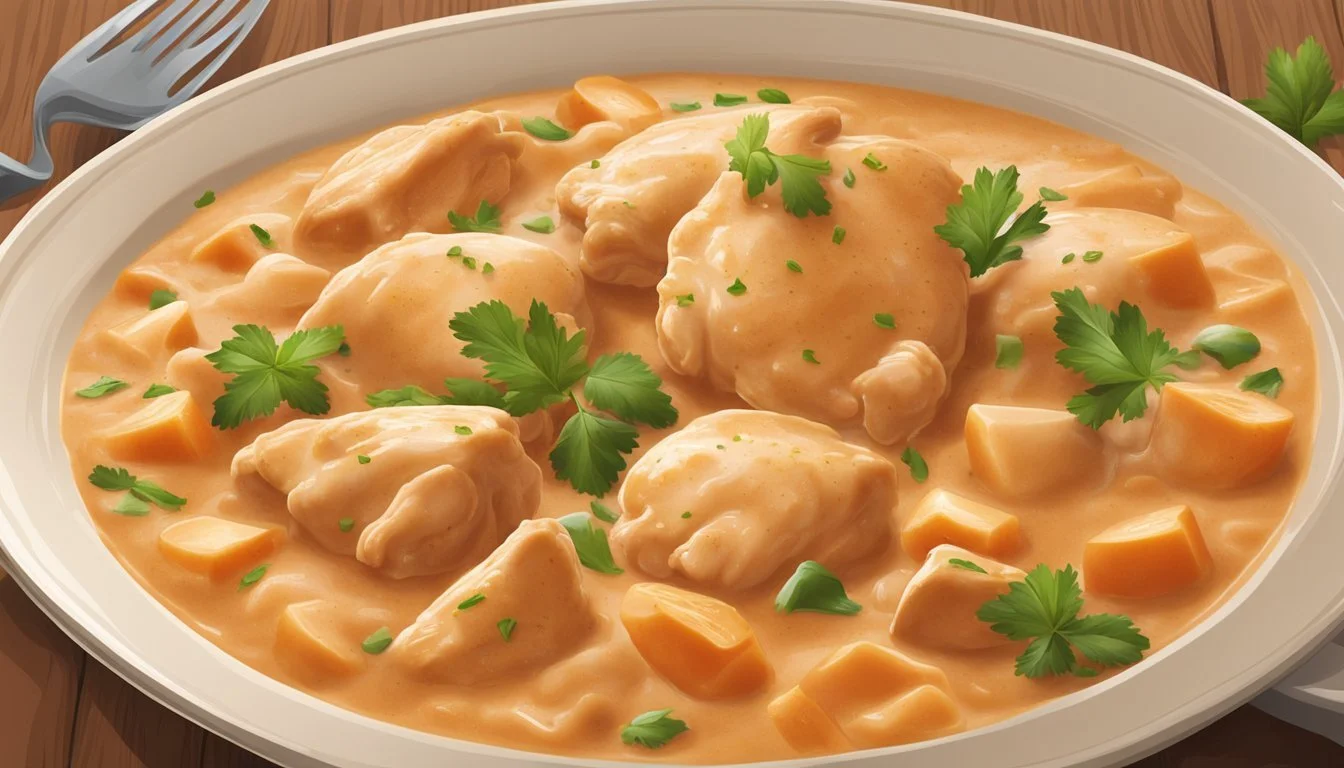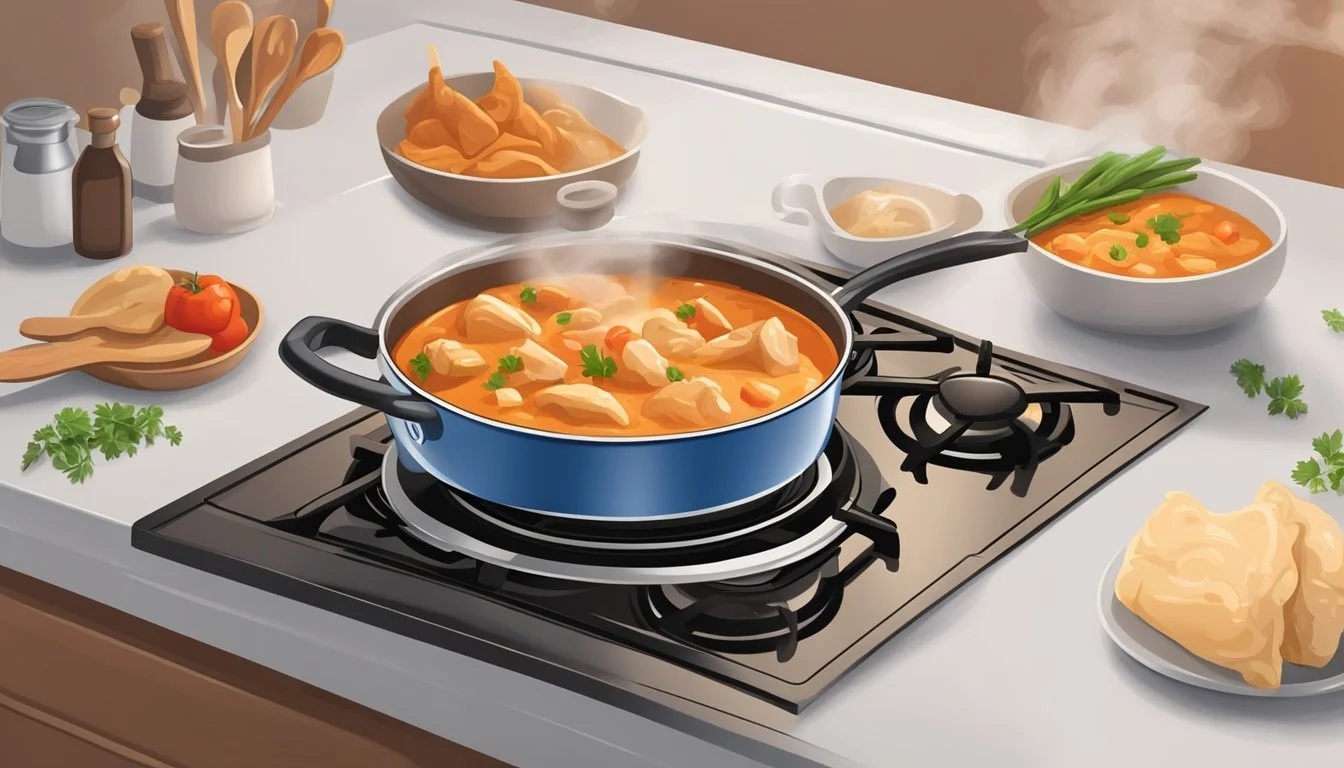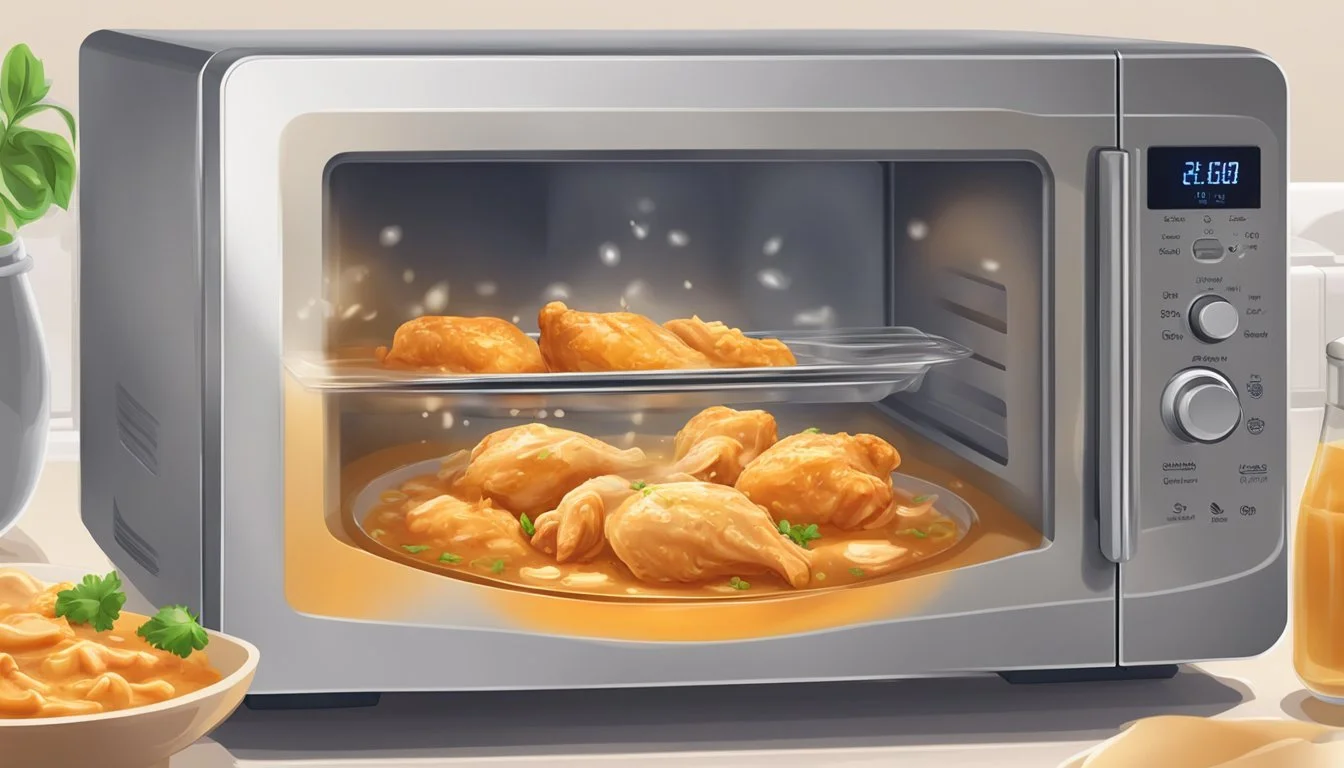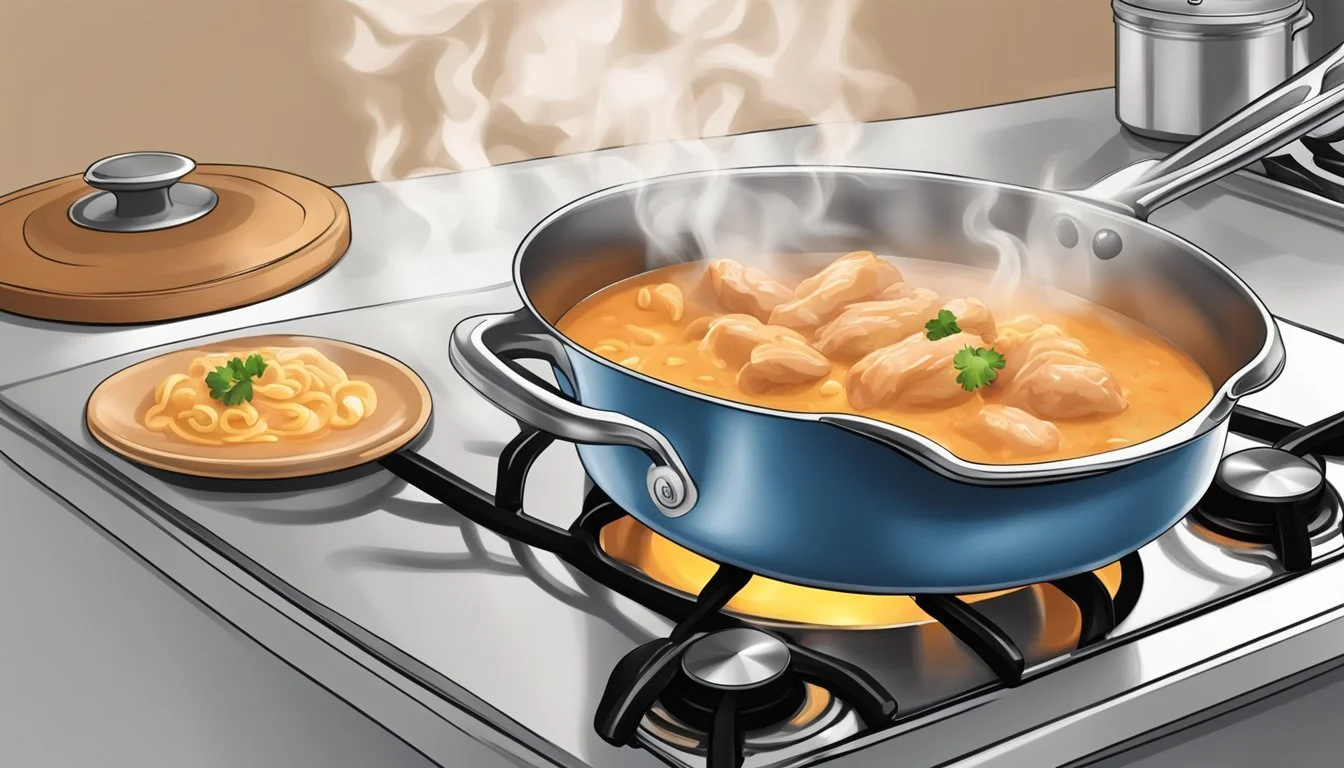Best Way to Reheat Chicken Paprikash
Tips for Preserving Its Creamy Texture and Flavor
Chicken Paprikash, with its rich flavors and creamy sauce, is a beloved comfort food that's well-renowned for its tender chicken and savory spice blend rooted in Hungarian cuisine. Maintaining the creaminess and tenderness of the dish upon reheating is essential to experiencing it as it was meant to be savored. This raises a common culinary question: what is the best way to reheat Chicken Paprikash without compromising its texture and flavor?
Reheating this dish requires a gentle approach to preserve its signature tender chicken and lush sauce. Care must be taken to ensure that the meat does not dry out and the sauce does not separate, which can be a challenge with cream-based dishes. An effective reheating method not only brings the dish to a safe temperature but also retains the integrity of its ingredients.
One of the keys to successfully reheating Chicken Paprikash lies in a low-and-slow technique, which allows the heat to penetrate the meat without removing its moisture. Equipped with the right method, the dish can be restored to its original state, ensuring that each bite offers a perfect harmony of flavor and texture.
Understanding Chicken Paprikash
Chicken Paprikash is a classic Hungarian dish, revered for its creamy sauce and tender meat. It traditionally combines the smokiness of paprika with the richness of sour cream, presenting as a quintessential example of Hungarian comfort food.
History and Significance
Chicken Paprikash, or csirkepaprikás in Hungarian, is a staple in Hungarian cuisine with origins in Central Europe. It is a beloved dish that reflects the Hungarian penchant for using paprika not just as a spice, but as a cornerstone of their culinary traditions. The dish gained popularity due to its simplicity and the heartiness it offers, often finding its way onto dinner tables during family gatherings and festive occasions.
Ingredients Breakdown
The primary ingredients in Chicken Paprikash include:
Chicken: A protein base, usually thighs or legs that maintain juiciness.
Paprika: This quintessential Hungarian spice gives the dish its distinctive color and smoky flavor.
Sour Cream: Adds creaminess and balances the spices.
Onion and Garlic: These aromatics provide a foundational flavor.
Bell Pepper: Often included for sweetness and texture.
Tomato: Sometimes incorporated for acidity and a hint of fruitiness.
Chicken Broth: Used to create a rich, savory sauce.
Flour: Combined with fats to thicken the sauce.
Sugar: Occasionally used to balance flavors.
These ingredients come together to form a dish that is both rustic and satisfying, with each playing a specific role in creating an authentic Chicken Paprikash.
Texture and Flavor Profile
The texture of Chicken Paprikash is characterized by tender pieces of chicken enveloped in a creamy, velvety sauce. It is commonly served over nokedli (Hungarian dumplings) or noodles, which act as the perfect vehicle to soak up the flavorful sauce.
In terms of flavor, Chicken Paprikash features a warm and slightly spicy taste from the paprika, which is mellowed by the cooling effects of sour cream. The layers of sweetness from onions and bell peppers, along with a hint of garlic, round out the dish, creating a comforting and full-bodied flavor profile synonymous with Hungarian home cooking.
Pre-Reheating Preparation
Properly storing leftovers and allowing them to reach room temperature are crucial steps one must take to ensure chicken paprikash maintains its creaminess and tenderness upon reheating.
Storing Leftovers Properly
One should store the leftover chicken paprikash in airtight containers or wrap it securely in plastic wrap to preserve its moisture and flavor. It's important to cool the dish quickly to inhibit bacterial growth before placing it in the refrigerator. If one opts to freeze the chicken paprikash, ensure it is sealed correctly to prevent freezer burn, which can greatly affect the texture and taste.
Refrigerator: Cool down for up to two hours before refrigerating.
Freezer: Freeze in portions for convenient thawing and reheating.
Bringing to Room Temperature
Prior to reheating, take the chicken paprikash out of the refrigerator and let it sit until it reaches room temperature. This allows the dish to reheat more evenly, reducing the risk of drying out the chicken as it warms up. The process should take about 20 to 30 minutes, depending on the quantity.
Remove from the fridge and let it sit, covered, on the counter.
Wait 20-30 minutes before reheating.
Reheating Methods Reviewed
Each reheating method has its own advantages and can be tailored to preserve both the creaminess and tenderness specific to Chicken Paprikash.
Oven Method
To maintain Chicken Paprikash's moisture using an oven, preheat the appliance to a moderate temperature, ideally around 350°F (175°C). The dish should be transferred to an oven-safe dish and covered with aluminum foil to prevent dryness. Reheat for about 20 minutes, or until it reaches an internal temperature of 165°F (74°C).
Stovetop Method
For reheating on a stovetop, one should use a skillet over medium heat. Add a small amount of Chicken Paprikash's sauce or water to the skillet to create steam, which helps keep the chicken moist. Stir gently and occasionally to ensure even warming.
Microwave Method
When urgent, the microwave offers a quick solution. Place Chicken Paprikash on a microwave-safe plate and cover it with a microwave-safe lid or plastic wrap to trap steam. Heat at a medium setting in short intervals, stirring in between to evenly distribute heat. Monitor closely to avoid overheating, which can toughen chicken.
Air Fryer Technique
While not traditional for Chicken Paprikash, an air fryer can reheat this dish by maintaining a lower temperature to avoid drying out the cream-based sauce. Set the air fryer to around 360°F (182°C) and heat in short bursts, checking frequently to safeguard the texture. This method may be best suited for portions without sauce or for items meant to retain crispness.
Step-by-Step Reheating Instructions
To maintain the creaminess and tenderness of chicken paprikash when reheating, one must adhere to specific steps for different reheating methods. The goal is to reach an internal temperature of 165°F while preserving the dish's texture and flavor.
Oven Reheating Steps
Preheat the oven to 350°F.
Place the chicken paprikash in an oven-safe dish. If dealing with skinless chicken breast, it should be covered to avoid drying out.
Cover the dish with aluminum foil to ensure even cooking and to retain moisture.
Reheat for about 10-15 minutes. Check the dish's internal temperature with a meat thermometer.
Stovetop Reheating Steps
Add a small amount of oil or broth to a skillet to prevent sticking.
Heat the skillet on medium heat.
Transfer the chicken paprikash to the skillet, stirring gently for an even reheat.
Once the internal temp reaches 165°F, remove from heat.
Microwave Reheating Steps
Place the chicken paprikash in a microwave-safe dish.
Cover the dish with a damp paper towel to keep the chicken moist during reheating.
Set the microwave to medium power and heat in one-minute intervals.
Stir between intervals to ensure even reheating and check for an internal temp of 165°F.
Air Fryer Reheating Steps
Preheat the air fryer to 360°F.
Place the chicken paprikash in the air fryer basket, avoiding overlap for even cooking.
Heat for about 4-6 minutes, or until the internal temp is 165°F.
If chicken paprikash contains a skin-on chicken breast, the air fryer can help maintain its crispiness.
Each method aims for a thorough and even reheating procedure to ensure the chicken paprikash is both safe to eat and still holds the savory qualities of its initial serving.
Troubleshooting Common Reheating Issues
When reheating Chicken Paprikash, one should focus on preserving the moisture of the chicken and the creamy consistency of the sauce. Using the correct technique can ensure that the dish retains its desired tenderness and flavor profile.
Avoiding Dryness
To prevent the chicken from drying out, they can add a small amount of water or chicken broth to the dish when reheating. The liquid should be just enough to create steam and maintain moisture without making the chicken soggy. The chicken should be covered with a lid or aluminum foil to trap the steam. They should heat the chicken to an internal temperature of 165°F to ensure it is warmed through without overcooking it.
Maintaining Sauce Consistency
For the sauce to keep its creamy texture, gentle and gradual reheating is key. If the sauce appears too thick upon reheating, the cook can slowly stir in a bit of liquid, such as milk or broth, to loosen it. They should use a whisk to distribute the liquid evenly and avoid lumps forming in the sauce. If the sauce separates, continuous whisking over a low heat can help re-emulsify it, restoring its smooth consistency. It’s important that they monitor the sauce closely and adjust the amount of liquid and heat as necessary.
Serving and Pairing Suggestions
When it comes to enjoying Chicken Paprikash, the serving temperature and the choice of accompaniments are crucial in enhancing its creamy and tender characteristics. The right side dishes and wine pairings can turn this meal into a delightful culinary experience.
Side Dishes
The ideal companions for Chicken Paprikash balance the dish with texture or refreshing contrast:
Noodles: Buttered egg noodles offer a classic pairing, providing a smooth and comforting bed that complements the creamy sauce.
Rice: For those preferring a different grain, steamed white rice or brown rice can absorb the sauce well, adding a pleasant chewiness to each bite.
Vegetables: Roasted vegetables or a crisp green salad provide a textural contrast and a refreshing counterpoint to the dish's richness.
Salad: A cucumber salad, dressed lightly with vinegar, can cleanse the palate and refresh the taste buds between mouthfuls of savory paprikash.
Wine Pairings
Selecting the right wine to serve with Chicken Paprikash enhances the flavors and overall dining experience:
White Wines: A full-bodied white wine like Chardonnay complements the creaminess without overwhelming the spices.
Red Wines: For those who prefer red, a medium-bodied Pinot Noir can harmonize with the dish's depth while respecting its delicate paprika flavor.
Health and Nutrition Considerations
When reheating Chicken Paprikash, one should consider the impact of the dish on their health and nutritional intake. Chicken Paprikash traditionally comprises boneless skinless chicken breasts, a lean protein source that provides essential amino acids with less saturated fat than other cuts. To maintain the healthiness of the dish, reheating should be done in a way that does not require additional fatty ingredients.
Olive oil, if needed to prevent sticking during the reheating process, is a healthier option than vegetable oil. It contains monounsaturated fats, which can benefit heart health when used in moderation.
Nutrition Facts:
Chicken breasts are high in protein and low in fat.
Olive oil has monounsaturated fats and antioxidants.
Kosher salt has a coarser grain than regular table salt, and because it's easier to sprinkle evenly, it often leads to using less salt overall in cooking, which is beneficial for maintaining a low-sodium diet.
During reheating, one needs to ensure that the creaminess of the sauce is preserved without diluting the nutritional value of the original ingredients. Herbs and spices can be added to enhance flavor while contributing minimal calories.
Ingredient Benefit Olive Oil Heart-healthy fats Chicken Breast High-quality protein, low fat Kosher Salt May result in lower sodium use
In summary, when reheating Chicken Paprikash, it's crucial to use health-conscious methods that maintain the dish's nutritional integrity while ensuring its creaminess and tenderness are preserved.






